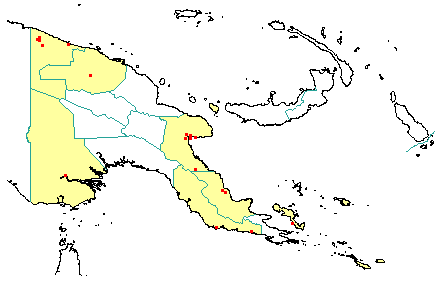
in PNGplants database
PNGTreesKey – Planchonia papuana Knuth |
Barry Conn (NSW) & Kipiro Damas (LAE).
Guide to trees of Papua New Guinea
Copyright held by the authors, National Herbarium of New South Wales, and Papua New Guinea National Herbarium
in Engler, H.G.A., Das Pflanzenreich 56 (1939)
Other Literature: J.J. Havel, Forest Botany, Part 2 Botanical Taxonomy 226 (1975) Fig. 63.
Family: Lecythidaceae
Dicotyledon
Timber Group: Occasional timber species Tradename: Planchonia
Field Characters: Large canopy tree (up to 35 m high); Bole cylindrical (40-100 cm diam.); straight (bole up to 15 m long); buttresses sometimes buttresses present or buttresses absent; spines spines absent; aerial roots aerial roots absent; stilt roots stilt roots absent; Bark brownish red or pale brown, rough or almost smooth, scaly or flaky, fissured, or slightly pustular, lenticels irregular; Subrhytidome (under-bark) red (pale (pink); less than 25 mm thick, 15.0-25.0; bark blaze consisting of one layer; strongly aromatic; pleasant; outer blaze pink, markings absent, very fibrous; inner blaze pink, markings absent, very fibrous; bark exudate (sap) absent; terminal buds not enclosed by leaves.
Indumentum: Complex hairs absent; stinging hairs absent; mature twig indumentum (hairs) absent.
Leaves: Leaves spaced along branches, spiral (leaves occurring singly at a node and arranged spirally up the branchlet), simple (a leaf composed of a single blade); petiole present, winged (lamina decurrent), attached to base of leaf blade, not swollen; leaves broadest above middle or broadest at or near middle (occasionally when young), (9.5-) 11.0-17.0 cm, 6.0-8.0 cm; symmetric, serrate to dentate (toothed), not dissected or lobed, acute, venation pinnate, secondary veins open, prominent, intramarginal veins absent; leaves lower surface pale green or green, upper surface green (glossy), indumentum (hairs) absent; absent; domatia absent; stipules present, free, laterally placed, not encircling the twig, leafy, not fringed, large, not persistent.
Flowers: Inflorescence terminal, flowers arising from a single point, cones absent; flowers bisexual, stalked, flowers with many planes of symmetry, 75.0 mm long, diameter large (more than10 mm diam.) (60 cm long); perianth present, with distinct sepals and petals whorls, inner perianth red or green (with reddish tinge); 4-5, free; stamens 100, present, joined (at base to form a staminal ring), free of the perianth; ovary inferior, carpels partially joined, by styles, locules 4; styles solitary, 1.
Fruits: Infrutescence arising from single point, fruit 40.0-50.0 mm long, green (glossy with sepals and style persistent), not spiny, slightly fleshy, simple, indehiscent, berry; seeds 100 (embedded in fleshy pulp), to about 5 mm long, not winged, narrow (longer than wide), seed 1-10 mm diam. (2-3 mm diam.).
Distribution: West Sepik, East Sepik, Morobe, Western, Central, Northern & Papuan Islands.
 | Botanical records in PNGplants database |